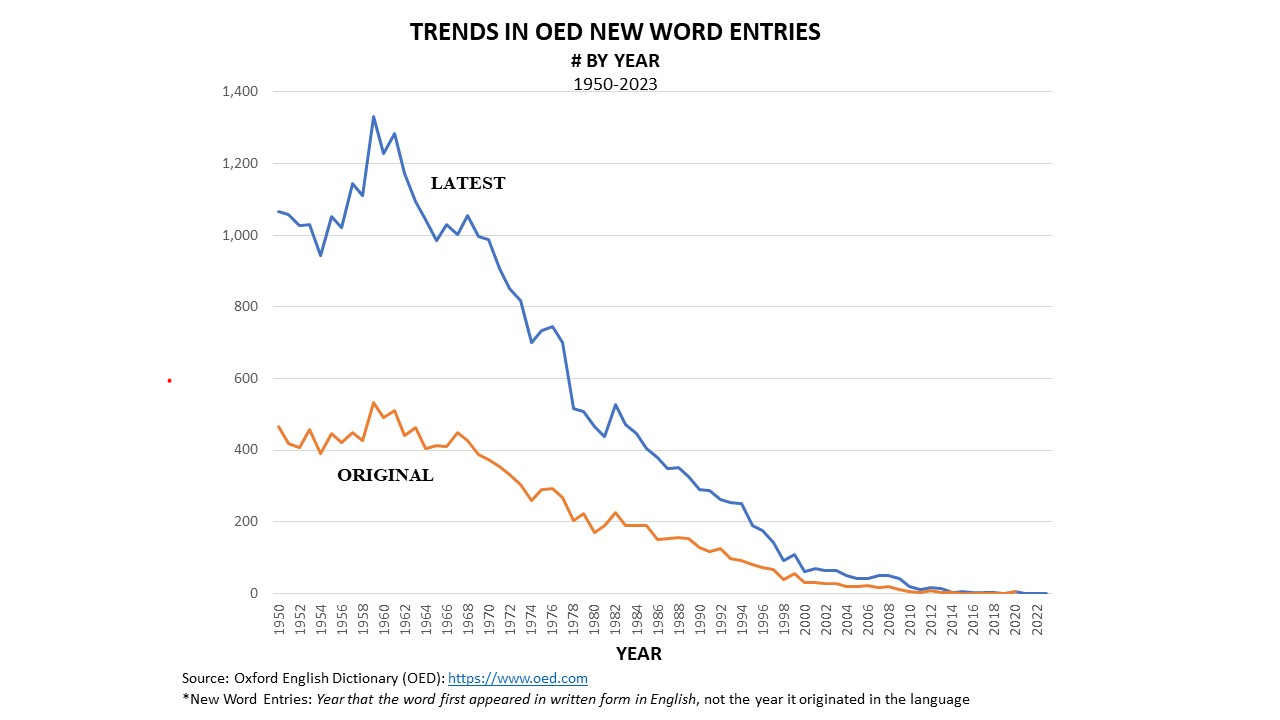Extracting an answering to a 'why' question only from the graphs is difficult, knowing something about word 'creation' or first appearances will help but we can only conjecture as to the inner workings of a business, the OED, that attempts to record these.
There are two ways to look at the problem, one as an artifact of language all by itself, the other as an artifact of the recording of language. Of course there is interaction, but I will try to keep them separate.
From the outside, considering no written record, the change in introduction of new items in the lexicon is mostly a sociological process. Given a one-time snapshot of the lexicon in Jan 1066 of mostly West Germanic vocab plus some Scandinavian, there are multiple waves and some continuous trends that influence acceptance of new words:
- the Norman invasion introducing a huge number of French words 1100-1300,
- the printing press increasing literacy and the acceptance of Latinate neologisms
- relatedly a general continuous process of academic and formal connections with Western Europe including the Rennaissance and later the Enlightenment
- the colonial expansion from 1500-1900 and immigrants from those colonies
- the scientific and industrial revolution of the 1800s bringing in many technical and medical neologisms
- the continued scientific and industrial expansion from the 1900s
Even single events like the Norman invasion didn't create a one time jump in vocab introduction. Everything is continuous but with some steeper bumps than others.
Of course even if a language was entirely isolated there is the constant change in vocab (both introduction and loss) that happens as a matter of course in language history (metaphors become dead metaphors, nouns are used as verbs, etc).
There is the difficulty of knowing how much the above listed sociological situations add to the lexicon. So now I'll turn to the record of language, writing and dictionaries.
Dictionaries like the OED, those that use a written record of a word to show that it is indeed a word. If it ain't written down it ain't a word to them.
For English, there is really just not much written record to go on (most European languages have an impoverished record before the printing press because most long-lasting writing was done in Latin by monasterial staff (books don't get recopied unless they are important enough and that was mostly religious then). Many words in the lexicon just didn't have representation in the written record. The printing press changed that - it became so much easier to print more words, but also, those words being more permanent, be counted and listed in a reference.
So that is why the introduction of the printing press, while promoting reading (and recognition of rarer words) was also an artifact in just recording words that were already in use but more permanently (on paper) long enough to be checked by lexicographers.
Everyone says that the vocabulary in English is always growing rapidly - you know, the internet and stuff. And that seems in contradiction to the graph presented where the number of new words per decade seems to be dropping off rapidly recently.
Most dictionaries have a lexicographical editorial policy of having a possible addition to the lexicon appear a reasonable number of times over a period of time (so as not to be considered slang that will quickly disappear). I think for the OED it is 10 years. So in some sense, even if some huge event occurs bring in new words tomorrow, there will -always- be a lag time where the new entries are almost negligible for a few years. This may be in a sense all the explanation that you're looking for.





